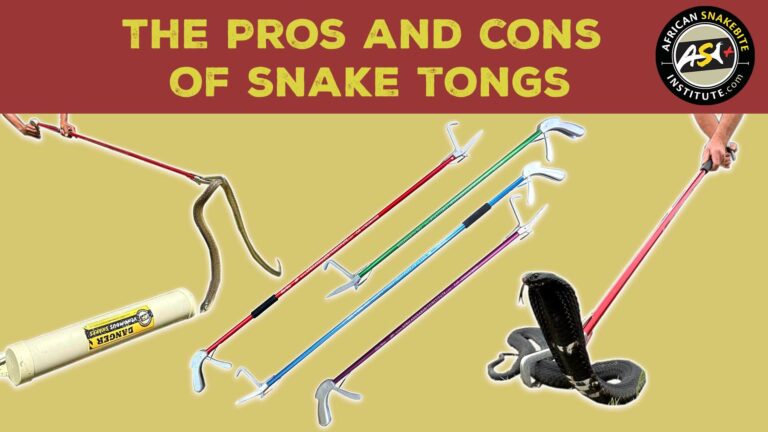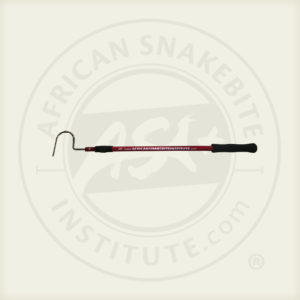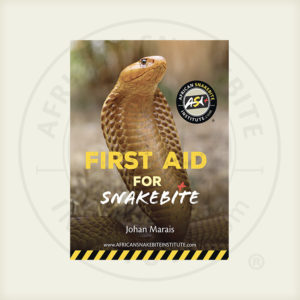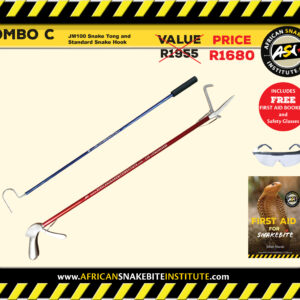Want to attend the course but can’t make it on this date?
Fill in your details below and we’ll notify you when we next present a course in this area:
 In the not-so-distant past ‘Snake removers’ where an unknown entity and unless you had a snake enthusiast living close by – most laypeople simply dealt with snake encounters themselves – and often with a firearm or spade. The advent of social media, WhatsApp groups and free apps like ASI Snakes has made reaching a snake remover in your local area far easier than it was 10 years ago.
In the not-so-distant past ‘Snake removers’ where an unknown entity and unless you had a snake enthusiast living close by – most laypeople simply dealt with snake encounters themselves – and often with a firearm or spade. The advent of social media, WhatsApp groups and free apps like ASI Snakes has made reaching a snake remover in your local area far easier than it was 10 years ago.
Until recently, snake tongs have been a tool only used by scientists and snake keepers and at snake parks. Using snake tongs is not rocket science, but knowing the right practices (where to grab, how much pressure to apply etc) is vitally important to both the user’s safety and obviously the safety of the snake.
Most young enthusiasts who started working at snake parks have to undergo training with snake tongs, often picking up cigarette butts from the car parks to gain experience in the fine motor coordination tongs require. Once you know the basics, using tongs is like riding a bike – it’s not something you forget easily.
Within the snake remover ‘industry’ there is a lot of talk about snake tongs. Some removers think they are the ultimate tool for safe snake removals, and some people think they are harmful to snakes, deeming them “death grippers”.
As with most animal capturing devices – in untrained hands they can cause damage. Wild animals are unpredictable and working with venomous snakes can be quite nerve wracking to the inexperienced hander. Dealing with fast-moving venomous snake on a hot day is no easy task and is often nerve wracking, depending on the skills and experience of the snake remover. That is why training is so important.
We train delegates in the use of snake tongs using several snake species (excluding the large adders, which we use snake hooks on) on all our courses. More than 4,000 delegates attend our courses every year.
For corporate training – making physical contact with snakes is a big no-no in terms of most sites’ health and safety protocols. They do not want their staff to take unnecessary risks – and tailing venomous snakes (catching a snake with a snake hook and grabbing its tail) is totally unnecessary and not a skill that should be taught to part-time snake removers that may only remove one or two snakes a year. The use of snake tongs on corporate sites is vital for safe snake removal.
Learning how to hook and tail or tong and tail venomous captive snakes on a course is quite different from working with a wild venomous snake in a difficult situation, and accidents can happen in the blink of an eye. Corporate insurers would deem this an unsafe technique and are unlikely to provide insurance for accidents as a result of tailing going wrong. Grabbing snakes by the tail is an advanced technique used by professional herpetologists or serious hobbyists and is certainly not suitable for corporates or inexperienced snake catchers.
So, what are the advantages of using snake tongs?
The remover is at least a meter (often 1.5 m) away from the biting end of the snake.
The snake can be caught and contained without the remover ever having to make physical contact with the snake (this is important for people who are nervous of snakes and a safety requirement on mines and other corporate sites).
Gently grabbing a snake at midbody with snake tongs is often far quicker than multiple failed attempts of hooking and tailing a fast-moving snake, especially a cobra that starts hooding. The less time it takes to capture and contain a snake, the less stress the animal faces and the safer it is for the handler.
Snake tongs offer the catcher more control over the snake and getting it safely contained. They also help with reaching snakes up trees or in rafters.
Using snake tongs in situations when you can only see sections of a snake is far more preferable than grabbing the snake by hand.
The disadvantages of using snake tongs?
In untrained hands, if squeezed too tightly, the tongs can cause damage to the snake. It is also important to grab the snake at midbody and not anywhere near the head. Grabbing a snake too close to the head causes it to twist and writhe which may hurt the snake. Proper training in how to use snake tongs is vital as is using suitable snake tongs.
Some people believe the snake is calmer being hooked and tailed, instead of being caught using snake tongs. This depends on the experience level of the person using the snake tongs. Inexperienced handlers may drop the snake or squeeze the tongs too hard.
Our CEO, Johan Marais has been using snake tongs for over 40 years – he has also travelled the world visiting snake parks and reptile researchers – and the use of snake tongs is an industry standard. His years of experience with snake tongs has helped in the successful development of our locally manufactured ASI Snake Tong range.
Snake tongs can be obtained from a number of pet shops and farmers supply stores, as well as online. There are a variety of snake tongs on the market – from high end imported Midwest tongs to very cheap Asian imports.
Those against the use of snake tongs believe that not just anyone should be allowed to purchase them, or that hooking and tailing or free-handling snakes (not using any equipment) is less stressful on the animal. There is no doubt that in untrained hands, snake tongs can cause damage. However, we see hundreds of images a day on our various social media platforms of freshly killed snakes, and yet very few images of snakes damaged by tongs. We would prefer that people attempt to remove and relocate a snake use snake tongs rather than chopping its head off with a spade.
We train well over 4,000 delegates a year (both members of the public and corporate delegates) in the proper use of snake tongs – and have never had an injury to any of our captive snakes on a course.
For those involved in snake removals or who are in the snake industry, keep up the good work. Educate people not to kill snakes or to attempt to catch snakes with braai tongs or welding gloves but rather to contact the local snake remover, and that there are courses where people can be taught how to safely deal with snakes that appear in gardens and houses.
Having been in this industry for many years we have seen great progress when it comes to educating people about snakes and not to kill every snake that is seen but we have a long way to go. Keep up the good work!
CONTACT US:
Product enquiries:
Caylen White
+27 60 957 2713
info@asiorg.co.za
Public Courses and Corporate training:
Michelle Pretorius
+27 64 704 7229
courses@asiorg.co.za
 ASI Collapsible Snake Hook - 1.2 m
R650.00
ASI Collapsible Snake Hook - 1.2 m
R650.00
 ASI First Aid for Snakebite Booklet
R40.00
ASI First Aid for Snakebite Booklet
R40.00
 ASI Combo C
R1,680.00
ASI Combo C
R1,680.00
Want to attend the course but can’t make it on this date?
Fill in your details below and we’ll notify you when we next present a course in this area:
Want to attend the course but can’t make it on this date?
Fill in your details below and we’ll notify you when we next present a course in this area:
Want to attend the course but can’t make it on this date?
Fill in your details below and we’ll notify you when we next present a course in this area:
Want to attend the course but can’t make it on this date?
Fill in your details below and we’ll notify you when we next present a course in this area:
Want to attend the course but can’t make it on this date?
Fill in your details below and we’ll notify you when we next present a course in this area:
Want to attend the course but can’t make it on this date?
Fill in your details below and we’ll notify you when we next present a course in this area:
Want to attend the course but can’t make it on this date?
Fill in your details below and we’ll notify you when we next present a course in this area:
Want to attend the course but can’t make it on this date?
Fill in your details below and we’ll notify you when we next present a course in this area:
Want to attend the course but can’t make it on this date?
Fill in your details below and we’ll notify you when we next present a course in this area:
Sign up to have our free monthly newsletter delivered to your inbox:
Before you download this resource, please enter your details:
Before you download this resource, would you like to join our email newsletter list?